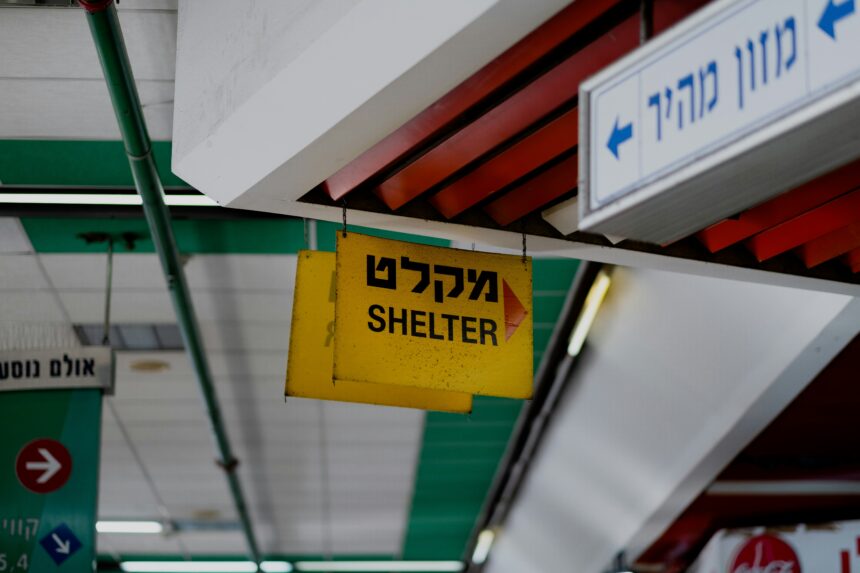Since Israel’s inception, the sound of a missile alert siren has triggered an immediate and deeply ingrained response: a rush to the nearest shelter. This reflex, developed due to the persistently unchecked threat of rocket fire, is presented as a measure to provide civilians with crucial seconds to reach safety and avoid harm from incoming projectiles.
However, a growing body of evidence raises serious questions about the true impact and consequences of this protocol. Under certain circumstances, the very act of urgently seeking shelter, prompted by the siren, may expose individuals to greater danger than remaining in their initial location.
The long history of missile attacks has ingrained the “run to shelter” response, making it challenging to shift public behavior, even if evidence suggests alternative approaches might be beneficial. Constant missile threat has created a conditioned response in the Israeli population. This ingrained behavior, while officially purported to be life-saving, may not be beneficial in all circumstances.
Can immediate shelter-seeking, triggered by short-notice alerts, lead to greater risks than remaining in place?
The Dangers of the Instinctive Rush: Documented Injuries and Psychological Conditioning
While those immediately rushing to shelter may hope to thereby save their lives, research has begun to document a significant and concerning phenomenon: injuries sustained not as a direct result of missile impacts themselves, but during the panicked scramble for safety. This has led to the recognition of “warning siren injuries” as a distinct category of harm in the context of missile attacks.
Research conducted at Sheba Medical Center during the May 2021 conflict between Israel and Gaza provides compelling evidence of this. The study revealed that dozens of individuals were treated for injuries incurred while attempting to reach shelters. These were not injuries caused by direct missile strikes; instead, they included fractures, bruises, and head injuries resulting from falls and collisions in the panicked movement following the siren.
This data underscores the inherent risks in the immediate and often chaotic response to missile alerts. Considering the sheer volume of sirens during periods of heightened conflict, even a relatively low percentage of injuries per siren event can translate to a considerable number of preventable casualties at the national level.
The Sheba Medical Center study also identified specific demographic groups as particularly vulnerable to these warning injuries. Elderly individuals, who may suffer from reduced mobility or be more prone to falls, and women, who may face different physical challenges in a sudden state of panic, were found to be at a higher risk of sustaining injuries while rushing to shelters.
Scenarios unfolding immediately after a missile siren often involve chaotic and potentially hazardous conditions. Individuals may find themselves navigating dark stairwells, increasing the risk of trips and falls. The sudden convergence of large numbers of people toward designated public shelters or communal security rooms can lead to severe overcrowding. There have even been reported instances of mass panic occurring in the desperate attempt to find safe haven, where people were injured in the crush of bodies trying to squeeze into already full shelters.
These accounts paint a picture of the potential dangers that can arise within the shelter-seeking process itself, where the urgency to find safety can create new threats. However, further research on the psychological impact of emergency situations, including missile attacks, has also begun to incorporate the costs associated with injuries sustained during the response phase.
One study assessing the potential costs of earthquake alerts in Israel integrated data on indirect injuries resulting from missile attacks, indicating that the risk of injury from urgent responses is a recognized factor across different types of threats. This underscores the broader point that panic and the urgency to act during an alarm, regardless of the specific danger, can lead to physical harm. Panic and the urgency to find shelter can override rational decision-making, leading to unsafe behaviors. The sound of a siren triggers a fear response, which can lead to people making hasty and potentially dangerous decisions in their rush to safety, such as navigating hazardous environments or pushing through crowds.
Consider an individual who is inside a sturdy home, even if it lacks a dedicated reinforced room. In such a scenario, the immediate environment might offer a reasonable degree of protection from shrapnel and blast effects, especially if the person can move to an inner room away from windows and exterior walls. In this context, the very act of leaving the house and running towards a public shelter that may be some distance away and potentially already crowded could expose them to more risks—such as falls, collisions, and the dangers of being in the open—than remaining inside their home, at least in the initial moments after the siren. Individuals inside sturdy homes, even without dedicated safe rooms, might be safer remaining indoors initially, especially in inner rooms away from windows and external walls. The act of exiting a relatively safe building and traveling to a potentially distant or already crowded public shelter can expose individuals to greater risks.
The element of time is also critical. The time spent running to a public shelter, particularly if it is not in close proximity, could expose an individual to danger for a longer duration than if they had remained in a relatively safe indoor location. In situations where the warning time is short, or the public shelter is some distance away, the risks associated with the journey may outweigh the perceived benefits of reaching the shelter, especially if the shelter is likely to be already crowded upon arrival.
It is noteworthy that the Home Front Command’s own guidelines prioritize sheltering options, with MAMAD/MAMAK being the most preferred, followed by shelters in buildings, then public shelters, and finally internal stairwells or inner rooms. This prioritization implicitly acknowledges that not all locations offer the same level of safety and suggests that staying in a more secure part of a building is preferable to immediately seeking a public shelter that may be less safe or less accessible.
A brief moment of assessment after an alert could allow individuals to choose the most appropriate immediate action based on their specific circumstances. A short pause to evaluate the immediate surroundings (e.g., “Am I already in a relatively secure place?”) could help people avoid unnecessary risks associated with hasty evacuation.
Beyond Physical Harm: Psychological Effects of Missile Warnings and Shelter-in-Place
Beyond the immediate physical dangers, the routine of an entire population, including children, being conditioned to abruptly halt their lives and seek shelter at any hour has profound psychological consequences. The constant state of alert and the repeated experience of fear and disruption may lead to significant long-term psychological damage and diminished quality of life. This conditioning becomes an essential ritual event, shaping the daily existence, mental attitude, and culture of the population.
The phenomenon of “warning siren injuries” further exacerbates this psychological distress. Moreover, the repeated disruption of daily life caused by frequent trips to shelters significantly impacts the sense of normality and overall well-being of individuals living in affected areas. These constant interruptions can create a persistent feeling of unease and make it difficult to engage in routine activities without a baseline anxiety about a potential siren.
Suffering a physical injury while trying to reach safety during an alert can compound the trauma associated with the missile threat itself, leading to increased anxiety and fear of future events. Frequent trips to shelters disrupt daily routines and significantly impact the sense of routine and overall well-being. This constant disruption can create a pervasive feeling of unease and make it difficult to engage in everyday activities without underlying anxiety.
Iron Dome factor: Impact on risk perception and defensive behaviors
Israel’s “Iron Dome” missile defense system has become a cornerstone of its security apparatus, purportedly able to intercept and destroy short-range rockets aimed at populated areas. Numerous sources claim a high rate of successful interceptions, although precise figures are subject to debate. The myth surrounding Iron Dome often portrays it as a highly effective shield against rocket attacks. However, the actual capabilities and limitations of the system are subjects of ongoing discussion and scrutiny.
In fact, the perceived Iron Dome success may contribute to a deterioration in public risk perception and defensive behaviors. The increased sense of security resulting from the publicized interception rate already led to a feeling of complacency among the population as hostilities were initiated on October 7th, when the opening rocket fire was discounted and ignored as routine.
If people believe that most incoming rockets will be neutralized by Iron Dome, they become less inclined to demand immediate and rigorous destruction of the attackers. This potential for a false sense of security is a significant concern, as Iron Dome, despite its purported effectiveness, is not a sufficient strategy for neutralizing enemy threats.
The psychological impact of Iron Dome may be to provide reassurance while lowering security by enabling the government to avoid decisive action. The focus on Iron Dome’s success might overshadow the importance of decisive victory. The narrative surrounding Iron Dome should not detract from the need to demand accountability from political and military leaders, an approach that is essential for maximizing civilian safety.
Towards a more proactive public safety strategy
The current blanket instruction to immediately run to a shelter may increase risks in various situations and populations.
A central consideration for revising public safety strategies is to empower individuals to make more informed decisions based on their immediate circumstances. This requires a shift from a purely reflexive response to a more conscious evaluation of the level of safety in one’s current location and the potential risks associated with seeking alternative shelter.
The current “run to shelter” message is simple, but might not be safe.
Conclusion: Re-evaluating missile alert response
While the immediate instinct to seek shelter upon hearing a missile siren has long been the accepted protocol, evidence indicates that this blanket instruction may increase risks.
The documented injuries sustained during the rush to shelters, the varying levels of safety offered by different environments, and the potential for overcrowding in public shelters all underscore the cost of a protracted defensive posture.
The routine psychological conditioning of the population to constantly seek shelter has become a significant event in itself, with far-reaching consequences for mental health and daily life.
The current system, while presented as a safety measure, demands a critical re-evaluation of its true costs and benefits. A paradigm shift is needed from a reactive “run to shelter” mentality to a more proactive approach to national defense.
Table 1: Types of Injuries Sustained While Seeking Shelter During the Israel-Gaza Conflict (May 2021)
| Type of Injury | Percentage of Patients | Specific Examples/Circumstances |
| Limbs | 50% | Fractures, sprains, bruises |
| Head Trauma | 29% | Concussions, lacerations |
| Torso | 25% | Bruises, strains |
| Note: | Elderly patients had a higher risk of injury. Women had a higher probability of hospitalization. |
Works cited
- Crisis Communication Saved Lives in Israel – PMC, https://pmc.ncbi.nlm.nih.gov/articles/PMC4219377/
- Physical Trauma Following Rocket Warning Sirens in Israel, https://academic.oup.com/milmed/article-pdf/188/9-10/e2896/51307793/usac343.pdf
- Physical Trauma Following Rocket Warning Sirens in Israel – PubMed, https://pubmed.ncbi.nlm.nih.gov/36383071/
- Characteristics and survival of hospitalized combat casualties during two major conflicts between Israel and Hamas: 2023 versus 2014, https://pmc.ncbi.nlm.nih.gov/articles/PMC11658454/
- Physical Trauma Following Rocket Warning Sirens in Israel – Oxford Academic, https://academic.oup.com/milmed/article/188/9-10/e2896/6825587
- Map depicting missile alerts during the initial 24 h of the… – ResearchGate, https://www.researchgate.net/figure/Map-depicting-missile-alerts-during-the-initial-24-h-of-the-Hamas-Israel-wara-The_fig1_379151169
- Be Prepared… Just in Case, https://consgerusalemme.esteri.it/wp-content/uploads/2024/01/LineeGuidaHomeFronCommand.pdf
- Rocket and Missile Attack- Guidelines for People with Mobility Impairments, https://www.oref.org.il/eng/articles/disabilities-elderly/mobility-impairment/3500
- My family’s preparations in case of missile strikes – U.S. Embassy in Israel, https://il.usembassy.gov/wp-content/uploads/sites/33/Home_Front_Command_Preparedness_Information.pdf
- Inside Tel Aviv’s Bomb Shelters as Israel Braces for Attack | WSJ News – YouTube, https://www.youtube.com/watch?v=x6F3fptcEww
- 12 Israelis injured in stampede after Houthi missile attack – The New Arab, https://www.newarab.com/news/12-israelis-injured-stampede-after-houthi-missile-attack
- Gaza Health Officials Fear Covid-19 Surge as Tens of Thousands Emerge From Crowded Bomb Shelters | Common Dreams, https://www.commondreams.org/news/2021/05/23/gaza-health-officials-fear-covid-19-surge-tens-thousands-emerge-crowded-bomb
- Clinical review: The Israeli experience: conventional terrorism and critical care – PMC, https://pmc.ncbi.nlm.nih.gov/articles/PMC1297605/
- Israeli bomb shelter became death trap Oct. 7 – Baltimore Sun eNewspaper, https://digitaledition.baltimoresun.com/tribune/article_popover.aspx?guid=3051154e-2f4c-46dd-abc9-8730894b11df
- 12 Israelis injured in shelter stampede following missile launch from Yemen, https://www.aa.com.tr/en/middle-east/12-israelis-injured-in-shelter-stampede-following-missile-launch-from-yemen/3440698
- Israelis told to clean and prepare their bomb shelters amid heightened regional tensions, https://saudigazette.com.sa/article/644610/World/Mena/Israelis-told-to-clean-and-prepare-their-bomb-shelters-amid-heightened-regional-tensions
- Israel Hamas War | Inside An Israeli Bomb Shelter – YouTube, https://www.youtube.com/watch?v=DiWZfcB1soM
- Air raid shelter – Wikipedia, https://en.wikipedia.org/wiki/Air_raid_shelter
- Israeli bomb shelter became death trap Oct. 7 – E-edition, https://digitaledition.carrollcountytimes.com/tribune/article_popover.aspx?guid=dc88a27b-9e0a-4b73-b348-486ffc74cd20
- People Rush To Get To Bomb Shelters In The Israeli City Of Haifa | Dawn News English, https://www.youtube.com/watch?v=dOkl1AWRezw
- Shelter Stampede In Israel After Houthi Missile Attack, China ‘Arming’ Yemeni Group For Safe Passage – YouTube, https://www.youtube.com/watch?v=y0JjGUE9EZI
- Missile Fired From Yemen Sparks Chaos In Israel; IDF Says Projectile Intercepted Over Saudi Airspace | International – Times of India Videos, https://timesofindia.indiatimes.com/videos/international/missile-fired-from-yemen-sparks-chaos-in-israel-idf-says-projectile-intercepted-over-saudi-airspace/videoshow/119201376.cms
- IDF downs Houthi missile as sirens send millions in central Israel to shelters at 4 a.m., https://www.timesofisrael.com/idf-downs-houthi-missile-as-sirens-send-millions-in-central-israel-to-shelters-at-4-a-m/
- Houthi Missile Hits Tel Aviv, 13 Israeli Citizens Injured – MINA News Agency – Minanews.net, https://en.minanews.net/houthi-missile-hits-tel-aviv-13-israeli-citizens-injured/
- The urgency-necessity earthquake alert trade-off: considering the public response factor, https://www.preventionweb.net/publication/urgency-necessity-earthquake-alert-trade-considering-public-response-factor
- National Emergency Portal | Defensive Guidelines – פיקוד העורף, https://www.oref.org.il/eng/articles/info/iron-swords/1100
- How does the Secure Space keep you safe | IDF, https://www.idf.il/en/mini-sites/regional-commands/home-front-command/how-does-the-secure-space-keep-you-safe/
- National Emergency Portal | Choosing a Protected Space – פיקוד העורף, https://www.oref.org.il/eng/articles/info/preparing-protected-space/1200/
- National Emergency Portal | Solutions for Securing your House, https://www.oref.org.il/eng/articles/emergency-preparedness/shelters-protected-rooms/2305
- National Emergency Preparation, https://www.nbn.org.il/life-in-israel/emergency-resources-life-in-israel-2/national-emergency-preparation/
- National Emergency Portal | How Much Time to Reach the Protected Space?, https://www.oref.org.il/eng/articles/haredim/iron-swords/4408
- Stay safe: The best places to go in the event of a rocket attack | The Times of Israel, https://www.timesofisrael.com/stay-safe-the-best-places-to-go-in-the-event-of-a-rocket-attack/
- Information and Guidelines for Emergencies for the Residents of Hod Hasharon, https://herum.hod-hasharon.muni.il/uploads/n/1723531087.1950.pdf
- National Emergency Portal | Rocket and Missile Attacks – Life-Saving Guidelines, https://www.oref.org.il/eng/life-saving-guidelines/rocket-and-missile-attacks/
- During an Alert – Move Away from the Car, https://www.oref.org.il/eng/articles/info/iron-swords/1104
- Smaller polygons and cell alerts: How Israel’s Home Front Command honed its civilian alert system – Breaking Defense, https://breakingdefense.com/2025/02/smaller-polygons-and-cell-alerts-how-israels-home-front-command-honed-its-civilian-alert-system/
- The safest room in the house | The Times of Israel, https://www.timesofisrael.com/the-safest-room-in-the-house/
- National Emergency Portal | Don’t Run to the Protected Space, https://www.oref.org.il/eng/articles/info/preparing-protected-space/1204
- Civil defense in Israel – Wikipedia, https://en.wikipedia.org/wiki/Civil_defense_in_Israel
- National Emergency Portal | Infiltration of Hostile Aerial Vehicle Alert, https://www.oref.org.il/eng/articles/security-threats/main/2000
- How to act during an alert? The Homefront Command’s Guidelines | IDF, https://www.idf.il/en/mini-sites/regional-commands/home-front-command/how-to-act-during-an-alert/
- HBS: Home Ballistic Shelter – Mifram Security, https://www.miframsecurity.com/solutions/products/hbs/
- Public Transportation | Tel Aviv-Yafo Municipality – עיריית תל-אביב-יפו, https://www.tel-aviv.gov.il/en/Live/Transportation/Pages/PublicTransportaiton.aspx
- Bomb Shelters | ISRAEL – Operation Lifeshield, https://www.operationlifeshield.org/services
- Last 30 days of rocket sirens in Israel in 30 seconds [OC] : r/MapPorn – Reddit, https://www.reddit.com/r/MapPorn/comments/17q4b7l/last_30_days_of_rocket_sirens_in_israel_in_30/
- The Protection Failure: How Millions of Israelis aren’t Safe From Rocket Fire, https://www.shomrim.news/eng/the-protection-failure
- Travel advice and advisories for Israel, the West Bank and the Gaza Strip, https://travel.gc.ca/destinations/israel-the-west-bank-and-the-gaza-strip
- Safety measures for employees in Israel Crisis – Workplace Wellbeing Professional, https://workplacewellbeing.pro/news/safety-measures-for-employees-in-israel-crisis/
- Reinforced school protects Israeli kids from Gazan rockets | The Times of Israel, https://www.timesofisrael.com/anti-rocket-school-protects-israeli-kids-near-gaza/
- SCHOOL SECURITY IN ISRAEL, https://www.cga.ct.gov/2013/rpt/2013-R-0119.htm
- The Israeli Approach to School Security – Campus Safety Magazine, https://www.campussafetymagazine.com/news/the-israeli-approach-to-school-security/11070/
- The Effectiveness of Rocket Attacks and Defenses in Israel | Request PDF – ResearchGate, https://www.researchgate.net/publication/324452243_The_Effectiveness_of_Rocket_Attacks_and_Defenses_in_Israel
- Sound of Sirens, Echoes of Trauma: Unpacking Socioeconomic Vulnerabilities in the Israel-Hamas Conflict – Preprints.org, https://www.preprints.org/manuscript/202310.0002/v1
- Full article: Sound of sirens, echoes of trauma: unpacking socioeconomic vulnerabilities in the Israel-Hamas conflict – Taylor and Francis, https://www.tandfonline.com/doi/full/10.1080/13537121.2024.2342136
- The Effectiveness of Rocket Attacks and Defenses in Israel, https://dr.library.brocku.ca/bitstream/10464/13431/1/ArmstrongMJ_IsraeliRocketDefenses_AcceptedManuscript.pdf
- Global protected area impacts | Proceedings of the Royal Society B: Biological Sciences, https://royalsocietypublishing.org/doi/10.1098/rspb.2010.1713
- Echoes of Terrorism: Examining the Effects of Siren Alerts Timing on Voter Preferences in Israel* – Ricardo Dahis, https://www.ricardodahis.com/papers/Bines,%20Dahis,%20Assuncao%20%282024%29%20Echoes%20of%20Terrorism.pdf
- Effectiveness of Rocket Attacks and Defenses in Israel – Oxford Academic, https://academic.oup.com/jogss/article/3/2/113/4964794
- The Effectiveness of Rocket Attacks and Defenses in Israel – Oxford Academic, https://academic.oup.com/jogss/article-pdf/3/2/113/24608402/ogx028.pdf
- Future Challenges for Israel’s Iron Dome Rocket Defenses – UMD School of Public Policy, https://spp.umd.edu/sites/default/files/2019-07/Future%20Challenges%20for%20Israel%E2%80%99s%20Iron%20Dome%20Rocket%20Defenses%20021618.pdf
- What the Gaza war reveals about the limitations of missile defense – Atlantic Council, https://www.atlanticcouncil.org/blogs/menasource/what-the-gaza-war-reveals-about-the-limitations-of-missile-defense/
- An assessment on Israel’s ‘Iron Dome’ Defense System, https://www.unav.edu/web/global-affairs/detalle/-/blogs/an-assessment-on-israel-s-iron-dome-defense-system
- Israel’s Missile Defense Performance: Views from the Gulf | The Washington Institute, https://www.washingtoninstitute.org/policy-analysis/israels-missile-defense-performance-views-gulf
- A False Sense of Security, Effective Shield or Morale… – Fathom, https://fathomjournal.org/a-false-sense-of-security-effective-shield-or-morale-booster-israels-missile-defence/
- Is Iron Dome a Poisoned Chalice? Strategic Risks from Tactical Success – RAND, https://www.rand.org/pubs/commentary/2017/11/is-iron-dome-a-poisoned-chalice-strategic-risks-from.html
- MIT Expert Says Israel’s Much-Vaunted Iron Dome Only 5% Effective – The Forward, https://forward.com/breaking-news/202642/mit-expert-says-israels-much-vaunted-iron-dome-onl/
- Sirens sound across southern Israel after 2 months of calm, https://www.israelhayom.com/2025/03/18/sirens-sound-across-southern-israel-after-2-months-of-calm/
- Working Hours in Israel – Rivermate, https://www.rivermate.com/guides/israel/working-hours
- Air raid sirens sound in Israel after a missile attack from Yemen – The Economic Times, https://m.economictimes.com/news/defence/air-raid-sirens-sound-in-israel-after-a-missile-attack-from-yemen/articleshow/119235584.cms
- Missile Defense: How Vulnerable Is Israel to Iran’s Attacks? | Council on Foreign Relations, https://www.cfr.org/expert-brief/missile-defense-how-vulnerable-israel-irans-attacks
- Assessing Israel’s Iron Dome Missile Defense System – FDD, https://www.fdd.org/analysis/memos/2019/11/13/assessing-israels-iron-dome-missile-defense-system/
- (PDF) Civilians under missile attack: post-traumatic stress disorder among the Jewish and Bedouin population of Southern Israel – ResearchGate, https://www.researchgate.net/publication/383069153_Civilians_under_missile_attack_post-traumatic_stress_disorder_among_the_Jewish_and_Bedouin_population_of_Southern_Israel
- Unseen Scars of War: Psychological Consequences of the Hamas Attacks on the Israeli Civilian Population – Jerusalem Center for Security and Foreign Affairs, https://jcpa.org/article/unseen-scars-of-war-psychological-consequences/
- Stress poisoning and bombs in northern Israel – Inspiration from Zion: This is a Love Story, https://inspirationfromzion.com/2024/10/16/stress-poisoning-and-bombs-in-northern-israel/
- What’s it like for Israelis to live under constant rocket fire and hide in a bomb shelter when someone attacks? : r/Israel – Reddit, https://www.reddit.com/r/Israel/comments/1gkkrvs/whats_it_like_for_israelis_to_live_under_constant/
- The Waves of Trauma – The Media Line, https://themedialine.org/top-stories/the-waves-of-trauma/
- Air raid sirens sound in Israel after a missile attack from Yemen – The Indian Express, https://indianexpress.com/article/news-today/air-raid-sirens-sound-israel-missile-attack-yemen-9895847/lite/
- Sirens heard in Tel Aviv, as Israel military reports missile attack from Yemen intercepted, https://apnews.com/video/sirens-heard-in-tel-aviv-as-israel-military-reports-missile-attack-from-yemen-intercepted-21c41b0428e24ed8a269eafb8ee55283
- Missile launched from Yemen intercepted by Israeli military – Investing.com, https://www.investing.com/news/stock-market-news/missile-launched-from-yemen-intercepted-by-israeli-military-93CH-3940181
- Civilians under missile attack: post-traumatic stress disorder among the Jewish and Bedouin population of Southern Israel – PMC – PubMed Central, https://pmc.ncbi.nlm.nih.gov/articles/PMC11321198/
- False missile alert may have ‘benefited’ people with anxiety – MedicalNewsToday, https://www.medicalnewstoday.com/articles/325898
- Echoes of Terrorism: Examining the Effects of Siren Alerts Timing on…, https://www.monash.edu/__data/assets/pdf_file/0010/3807064/2024-16.pdf
- Emergency situations and deaf people in Israel: Communication obstacles and recommendations – PMC, https://pmc.ncbi.nlm.nih.gov/articles/PMC5314894/
- RedAlert – Alerts in Israel on the App Store, https://apps.apple.com/us/app/redalert-alerts-in-israel/id937914925





